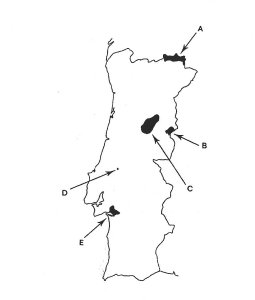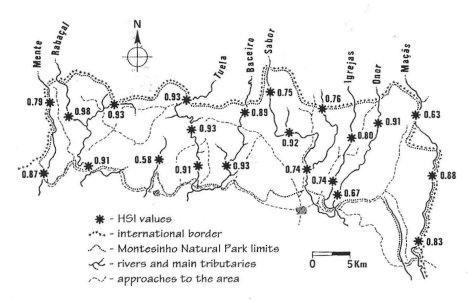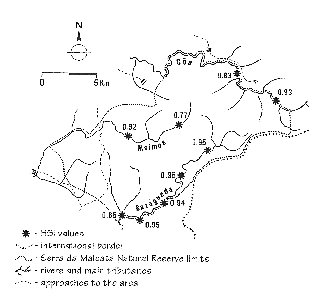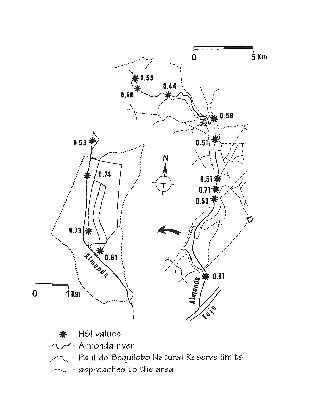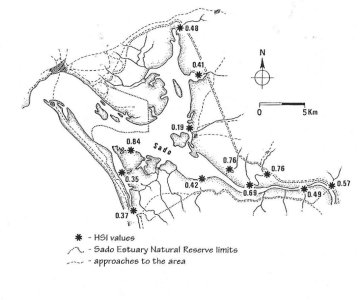 |
Last Update:
Thursday November 22, 2018
|
| [Home] |
INTRODUCTION Although otter (Lutra lutra L., 1758) population presents a tendency towards regression in much of its European range, in Portugal it still has a fairly stable population. The project OTTER CONSERVATION IN PORTUGAL is being carried out in five different protected areas of the country (Figure 1): Montesinho and Serra da Estrela Natural Parks, and Serra da Malcata, Paul do Boquilobo and Estuário do Sado Natural Reserves. These areas include different habitats: rivers, upland oligotrophic streams, dams, lagoons, marshes, lowland rivers and fish farm ponds. The methodology used was based on MACDONALD and MASON (1982). The surrounding areas of the transepts were carefully characterised, allowing an evaluation of the habitat suitability for the species, based on the necessary basic requisites to otter’s presence (adequate presence of vegetation, water and preys) and human disturbance. The Habitat Suitability Index (HSI) which includes variables like vegetation presence, water availability, water pollution, macroscopic pollution and presence of human activities, was used as a measure to such characterisation. We present the distribution and the local situation of the otter in these areas, the main threats observed and some measures that can be implemented to improve the habitat conditions to Lutra lutra. MONTESINHO NATURAL PARK Montesinho is located on the edge of Iberian plateau, in a region characterised by its undulated relief, in Northeast Portugal (Figure 2). The otter is present in all rivers of the park being its signs of presence commonly seen along these rivers and their main tributaries. The main threats to Lutra lutra in Montesinho are water deviations and hydroelectric enterprises, destruction by fire or cutting of the riparian vegetation, illegal fishing with poisons (by its impact on fish populations) and mining and gravel extraction (this factor being less important). It is advisable to control and plan the policies and enterprises concerned with the management of the water resources, and to intensify the efforts of watching in order to prevent fires and illegal cuttings and fishing.
SERRA DA ESTRELA NATURAL PARK The Natural Park of Serra da Estrela, the highest mountain in continental Portugal, shows a great variety of freshwater habitats (rivers, streams, lagoons, and water reservoirs), included in an extensive basin (Figure 3). Lutra lutra presence was detected in all types of habitats present in the area. The main factors of stress are: discharging of domestic and industrial effluents without a previous treatment; no control of the sediments' extraction; destruction of riparian vegetation; large uncontrolled tourist concentrations, specially those which occur every year in the highest altitudes The major conservation measures are development of freshwater management policies, the recovery of the disturbed streams and the improvement of tourist activities on lower altitudes.
SERRA DA MALCATA NATURAL RESERVE Baságueda, Côa and Meimoa are the main watercourses of this protected area (Figure 4). All of them have a torrential regimen with great flow reductions during warm periods. They flow through an undisturbed watershed, which exhibits a well-developed riparian vegetation. The species is widespread and abundant all over the area. A high habitat quality with no pollution and high availability of prey and refuges can be found inside the Reserva Natural da Serra da Malcata. Significant reductions in water quantity, due to excessive pumping for agricultural activities during the summer months must be carefully monitored.
PAUL DO BOQUILOBO NATURAL RESERVE The Paul do Boquilobo Natural Reserve is a marshland situated between the Tejo and Almonda rivers, in central Portugal (Figure 5). The otter occurs in all river, being its presence sporadic upstream and more regular on the Paul do Boquilobo and downstream. The strong pollution of the river caused by industrial, agriculture and urban effluents, and the destruction of the bankside vegetation, are the major problems of this area. However, the direct death caused by the fishers is a threat as well. The conservation measures to be carried out in this area are mainly the treatment of the industrial and urban effluents, the management and recovery of the bankside vegetation and the implementation of an environmental education campaign directed to the fishers.
ESTUÁRIO DO SADO NATURAL RESERVE This reserve is a very important wetland (Figure 6) supporting a rich variety of wildlife species and a wide range of aquatic habitats including the estuary, salt marshes, rivers, small streams and lagoons. Rice fields and fish farm ponds can also be found. Lutra lutra is considered to be relatively abundant over most of the Reserve area. Nevertheless increasing stressing factors are threatening the species in some places. The major causes of threat are water pollution resulting from industrial and agricultural effluents and the high level of human disturbance mainly due to fish farming activities. Several otters are certainly poached each year. The main conservation measures are educational campaigns, effective surveillance of water quality and the implementation of a specific monitoring plan of the otter population.
FINAL CONSIDERATIONS Portugal still has one of the most viable otter populations in Europe. Montesinho, Serra da Estrela and Serra da Malcata have good conditions to the existence of the species (medium HSI values range 0.81-1.00, n = 30), not only in terms of habitat suitability (adequate presence of vegetation, water quality and quantity and preys), but also because of the relative reduced disturbance. The other two areas, Paul do Boquilobo e Estuário do Sado (medium HSI values range 0.41-0.60) have more acute problems with conservation, mainly due to intensive agriculture and to domestic and industrial pollution in the freshwater and estuarine systems. Nevertheless otters are still present all over these areas, being common in Estuário do Sado Reserve. These results are similar to the data we are obtaining from the national survey of otter distribution that has been carried out since the beginning of 1995, following the standardized methodology (MACDONALD and MASON, 1982). The preliminary results seems to confirm that Lutra lutra is widely distributed all over the country, living in a great variety of habitats ranging from coastal waters in the Southwest to freshwater inland, and being quite abundant in many areas. REFERENCES Anonymous (1981): Standards for the development of habitat suitability index models. Division of Ecological Services, Dept. of the Interior, Washington D.C., 103 ESM. |
| [Copyright © 2006 - 2050 IUCN/SSC OSG] | [Home] | [Contact Us] |
